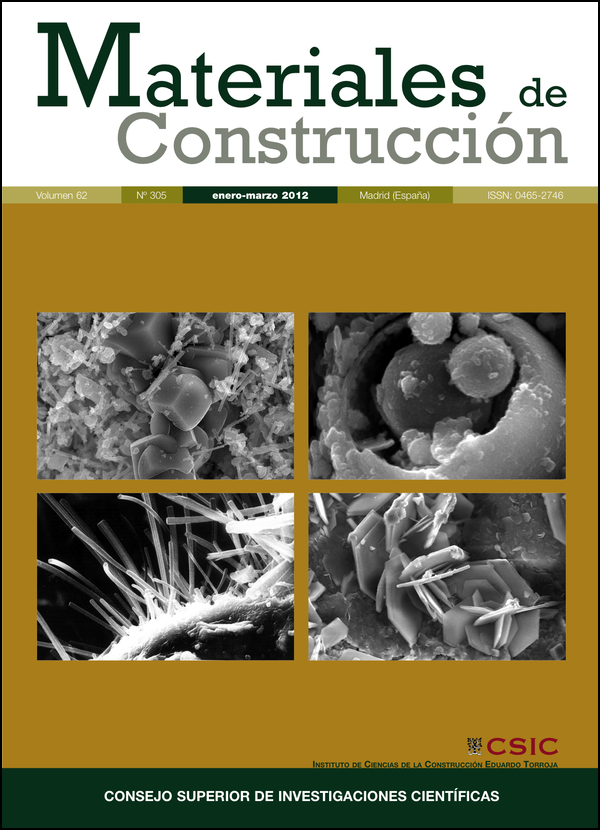Análisis sobre la influencia de la densidad en la termografía de infrarrojos y el alcance de esta técnica en la detección de defectos internos en la madera
DOI:
https://doi.org/10.3989/mc.2012.62410Palabras clave:
termografía de infrarrojos, madera, densidad, detección de defectos internos, deterioroResumen
En el presente artículo se muestran los resultados obtenidos en una fase de laboratorio al tratar de determinar el alcance de la termografía de infrarrojos en la detección de defectos internos en la madera y, por otro lado, cómo interviene la densidad de este material sobre la temperatura superficial mostrada en un termograma. Para ello se ha desarrollado un trabajo experimental donde se han controlado una serie de parámetros ambientales y de trabajo (temperatura ambiente, humedad relativa, distancia al objetivo…), y se ha sistematizado el proceso utilizando piezas de distintas especies de madera (distintas densidades) y diseñando una serie de probetas donde se han analizado varias casuísticas posibles en cuanto a tamaño y posición interna de los daños. Análogamente, sobre estas probetas se ha estudiado el efecto que produce sobre la imagen termográfica un incremento de humedad interna en el defecto asociada normalmente a los fenómenos de pudrición de la madera.
Descargas
Citas
(1) Colantonio, A., Gonçalves, M., Gendron P.: Commissioning of exterior building envelopes of large buildings for air leakage and resultant moisture accumulation using infrared thermography and other diagnostic tools. Thermal solutions (2007), pp. 1-12.
(2) Balaras, C. A., Argiriou, A. A.: Infrared thermography for building diagnostics. Energy and buildings, 34 (2002), pp. 171-183.
(3) Clark, M. R., McCann, D. M., Forde, M. C.: Application of infrared thermography to the non-destructive testing of concrete and masonry bridges. NDT&E International 36 (2003), pp. 265–275. http://dx.doi.org/10.1016/S0963-8695(02)00060-9
(4) Luong, M. P.: Change of thermal images of lumber including knots, finger joints and metal connectors. Bull Kyoto Univ For 69 (1996), pp. 114-128.
(5) Tanaka, T.: Wood inspection by thermography. Wood NTD-2000 – 12th International Symposium on non-destructive testing of wood, vol. 6, nº 3 (2000).
(6) Wyckhuyse, A., Maldague, X.: A study of Wood Inspection by Infrared Thermography. Part I: Wood Pole Inspection by Infrared Thermography. Research in Nondestructive Evaluation (2001), pp. 1-12.
(7) Wyckhuyse, A., Maldague, X.: Wood Inspection by Infrared Thermography. Part II: Thermography for Wood Defects Detection. Research in Non destructive Evaluation (2001), pp. 13-21.
(8) Ludwig, N., Redaelli, V., Rosina, E., Augelli, F.: Moisture detection in wood and plaster by IR thermography. Infrared Physics & Technology vol. 46 (2004), pp. 161-166. http://dx.doi.org/10.1016/j.infrared.2004.03.020
(9) Gilberg, M., Riegel, C., Melia, B.: Leonard J. Detecting Subterranean Termite Activity with Infrared Thermography: A Case Study. APT Bulletin, vol. 34, nº 2/3 (2003), pp 47-53. http://dx.doi.org/10.2307/1504822
Descargas
Publicado
Cómo citar
Número
Sección
Licencia
Derechos de autor 2012 Consejo Superior de Investigaciones Científicas (CSIC)

Esta obra está bajo una licencia internacional Creative Commons Atribución 4.0.
© CSIC. Los originales publicados en las ediciones impresa y electrónica de esta Revista son propiedad del Consejo Superior de Investigaciones Científicas, siendo necesario citar la procedencia en cualquier reproducción parcial o total.
Salvo indicación contraria, todos los contenidos de la edición electrónica se distribuyen bajo una licencia de uso y distribución “Creative Commons Reconocimiento 4.0 Internacional ” (CC BY 4.0). Consulte la versión informativa y el texto legal de la licencia. Esta circunstancia ha de hacerse constar expresamente de esta forma cuando sea necesario.
No se autoriza el depósito en repositorios, páginas web personales o similares de cualquier otra versión distinta a la publicada por el editor.
















